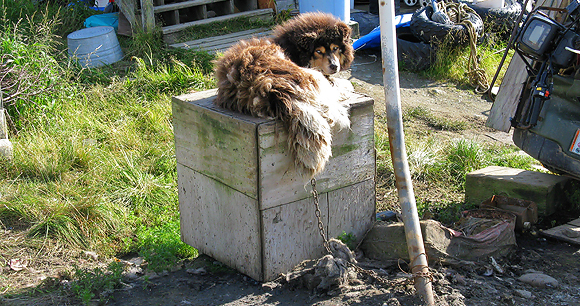
Across the United States, millions of dogs endure their entire lives confined outdoors by chains affixed to collars and staked to the ground or a fixed object. This is called “chaining” or “tethering.” Typically, the animals are denied socialization with people and other animals and even basic veterinary care.
The short radius afforded them by their chains limits the dogs to a small area of hard packed earth (or mud) and an accumulation of their own feces. The dogs can become entangled in the chains or the chains can get hung up in trees or other obstacles. Because of neglect, the collars around the dogs' necks can cause irritation and rub the flesh raw. With many of the animals chained as puppies, as the dogs grow, their collars become imbedded in the poor animals' necks.
In general, some shelter is mandated, but it is often times inadequate and the animals are still subjected to weather extremes—heat, bitter cold, rain or snow. The dogs are denied love and attention from people, and this lack of socialization causes some—who would not otherwise be a threat—to become aggressive and attack and bite people, particularly children. Some children have even been killed.
Education coupled with legal restrictions or prohibitions can facilitate an end to chaining. Currently, over one hundred communities in more than thirty states have passed laws restricting or banning the practice.
Animal Welfare Act
The USDA issued the following statement in the July 2, 1996 Federal Register: “Our experience in enforcing the Animal Welfare Act has led us to conclude that continuous confinement of dogs by a tether is inhumane. A tether significantly restricts a dog's movement. A tether can also become tangled around or hooked on the dog's shelter structure or other objects, further restricting the dog's movement and potentially causing injury.”
In 1997, the USDA issued a final rule that entities regulated under the Animal Welfare Act could no longer keep dogs continuously chained, “The dog-tethering rule is designed to prevent the practice of permanently tethering dogs and not allowing them proper exercise as specified under the Animal Welfare Act.”
Section 3.6(c)(4) of the USDA regulations for enforcement of the Animal Welfare Act state: “Permanent tethering of dogs is prohibited for use as primary enclosure. Temporary tethering of dogs is prohibited for use as primary enclosure unless approval is obtained from APHIS.”
For more information on this topic, please visit Unchain Your Dog and Unchained Melodies.